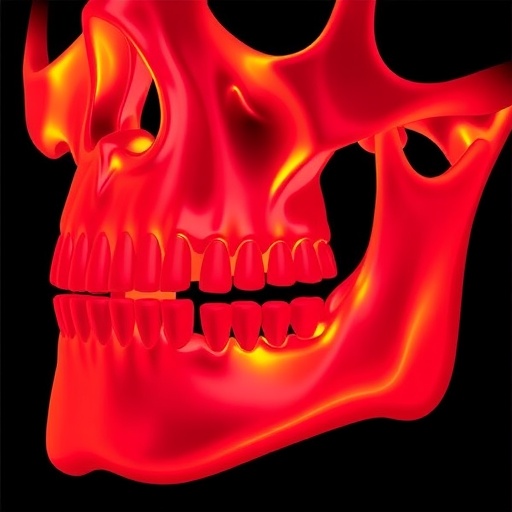In a groundbreaking study that melds computational modeling with experimental validation, researchers have unveiled the remarkable capabilities of patient-specific mandibular reconstruction plates. This revolutionary development aims to address the significant biomechanical challenges faced during traditional mandibular reconstructions, where the complexity of individual anatomical variations often leads to suboptimal outcomes. This focus on personalization represents a compelling advancement in the field of bioengineering and biomedical devices, reflecting the urgent need for more tailored solutions in surgical interventions.
Mandibular reconstructive surgeries are frequently necessitated by traumatic injuries, tumors, or congenital defects. These procedures are complex due to the mandible’s role in essential activities such as mastication, respiration, and articulation. The anatomy of the mandible varies significantly from person to person, thus highlighting the inadequacies of standardized plates that may not provide optimal biomechanical support. This study presents a significant shift from traditional methods, emphasizing the need for tailored solutions that can adapt to individual patient profiles.
The validated computational framework described in the research draws on advanced finite element analysis, allowing for the precise simulation of mechanical stresses and strains on the customized plates. By utilizing patient-specific imaging data, the researchers were able to create models that reflect the unique anatomical features of each patient’s mandible. This precision not only enhances the fit of the reconstruction plates but also aims to improve the overall mechanical integrity and functional outcomes.
Experimental validation of the computational models involved rigorous biomechanical testing. The researchers subjected the customized plates to various loading conditions that mimic real-life scenarios patients may encounter following surgery. The results were illuminating, demonstrating that the patient-specific plates were superior to their standard counterparts in terms of load-bearing capacity and performance under stress. This suggests that personalized plates could substantially reduce the risk of complications, ensuring better long-term patient outcomes.
The integration of computational and experimental methodologies represents an essential leap forward in surgical technology. This dual approach not only provides a deeper understanding of the mechanics involved but also establishes a framework for continuous improvement and adaptation in surgical practices. The implications for clinical applications are profound, as this model could potentially be extended to other reconstructive procedures, ushering in a new era of patient-centered surgical care.
Moreover, the impact of biomechanical optimization on the healing process cannot be understated. Improper load distribution on implanted materials could lead to complications such as plate failure or delayed healing. By ensuring that the load is distributed evenly across the structure, the patient-specific plates can facilitate a faster recovery, enhancing the overall success rates of mandibular reconstructions.
As more surgeons and medical professionals become aware of the benefits associated with patient-specific solutions, we may witness a paradigm shift in surgical practices. This research not only validates the effectiveness of personalized surgical devices but also emphasizes the importance of collaborative efforts between engineers and medical practitioners in improving patient care.
The potential for this research to influence future studies is significant. The methodology established can be replicated across various fields within medicine and engineering, advancing the development of tailored solutions for a myriad of surgical challenges. As this line of research continues to evolve, further advancements in computational technology and materials science could yield even more effective solutions for complex medical procedures.
In conclusion, the study by Zhong et al. represents a vital step toward revolutionizing mandibular reconstructive surgery. By providing a validated computational-experimental framework for the development of patient-specific plates, it sets a precedent for future innovations. The work opens the door for more personalized approaches in various surgical fields, demonstrating that the union of technology and medicine has the power to enhance patient outcomes in unprecedented ways.
Patients undergoing reconstructive surgery have often faced the daunting challenge of uncertainty regarding their recovery. The introduction of patient-specific reconstruction plates is a promising development that could alleviate some of this uncertainty, providing tailored solutions that conform more closely to the individual needs of each patient. Given that mandibular reconstruction plays such a crucial role in a patient’s quality of life, the significance of this research cannot be overstated.
The future of biomaterials and surgical reconstruction is bright, thanks to pioneering research like this. With each step forward, we get closer to a future where surgeries can be tailored precisely to individual anatomical and functional requirements. As medical professionals embrace these advancements, it is likely that patient outcomes will continue to improve, ultimately leading to a comprehensive understanding of the biomechanics involved in surgery.
While challenges remain—such as regulatory hurdles, cost implications, and the need for widespread surgeon training—the framework laid by this study provides an optimistic outlook for future research. The continuous refinement of patient-specific models will undoubtedly lead to improved designs and materials, paving the way for a new standard of care in surgical practices worldwide.
Subject of Research: Patient-specific mandibular reconstruction plates and their biomechanical performance.
Article Title: Superior Biomechanics of Patient-Specific Mandibular Reconstruction Plate: A Validated Computational–Experimental Framework.
Article References: Zhong, S., Zhang, Y., Shi, Q. et al. Superior Biomechanics of Patient-Specific Mandibular Reconstruction Plate: A Validated Computational–Experimental Framework. Ann Biomed Eng (2025). https://doi.org/10.1007/s10439-025-03878-w
Image Credits: AI Generated
DOI: https://doi.org/10.1007/s10439-025-03878-w
Keywords: Mandibular reconstruction, patient-specific plates, biomechanics, computational modeling, surgical innovation.
Tags: advanced imaging in reconstructive surgeryanatomical variations in mandiblebiomechanical challenges in mandible surgerycomputational modeling in surgerycustom surgical plates for mandiblefinite element analysis in biomedical devicesmandibular reconstruction innovationspatient-specific mandible platespersonalized bioengineering solutionssurgical outcomes improvementtailored surgical interventionstrauma-related jaw reconstruction





